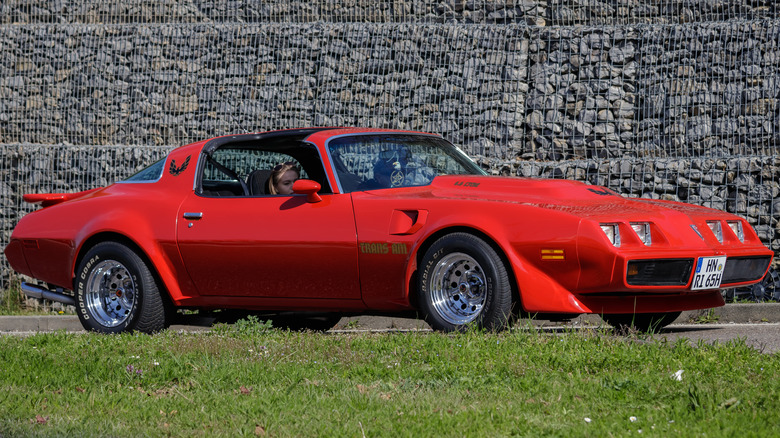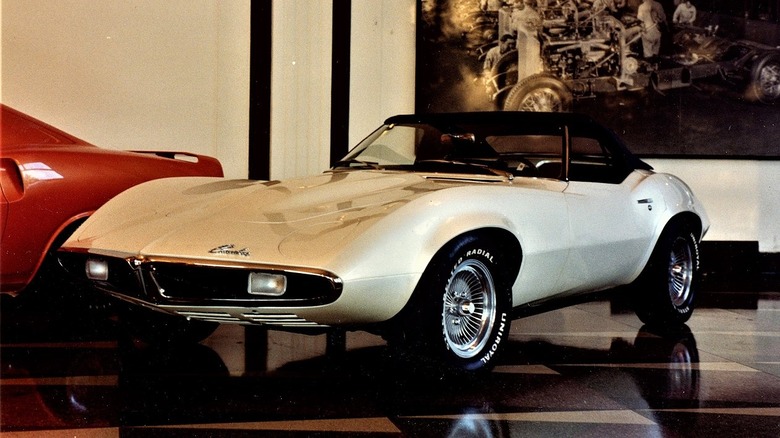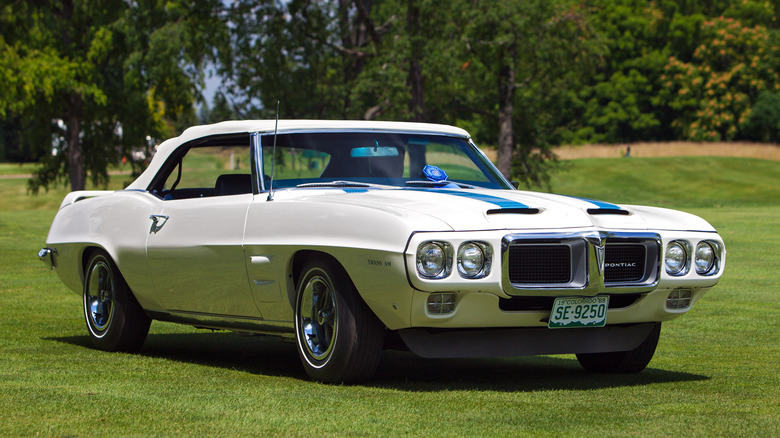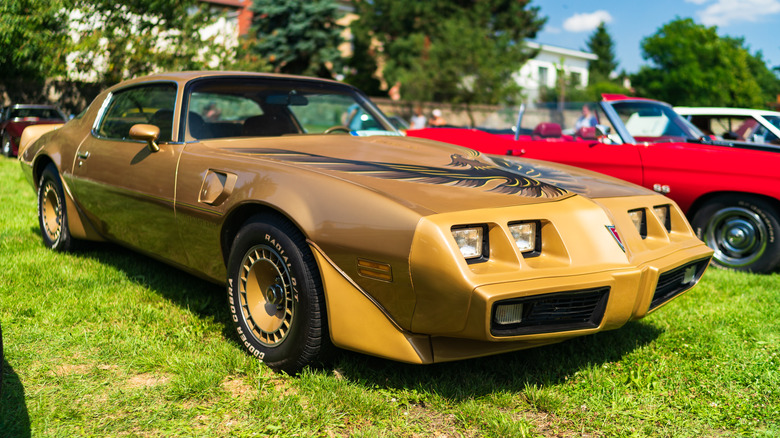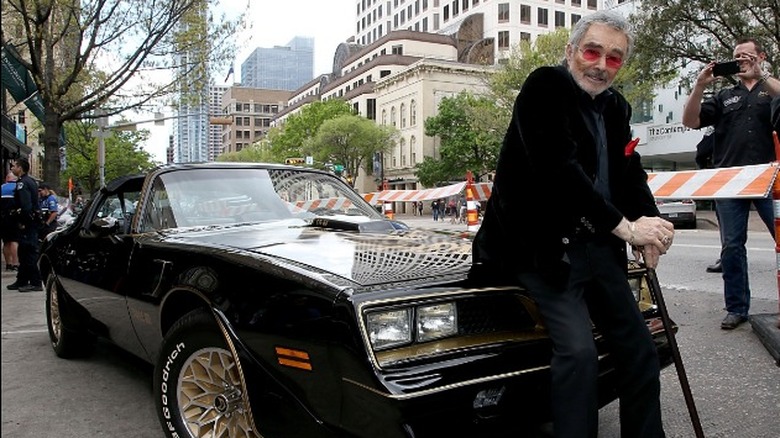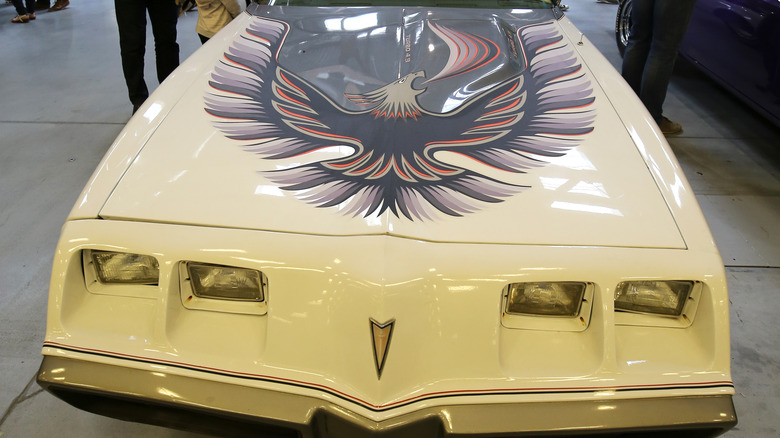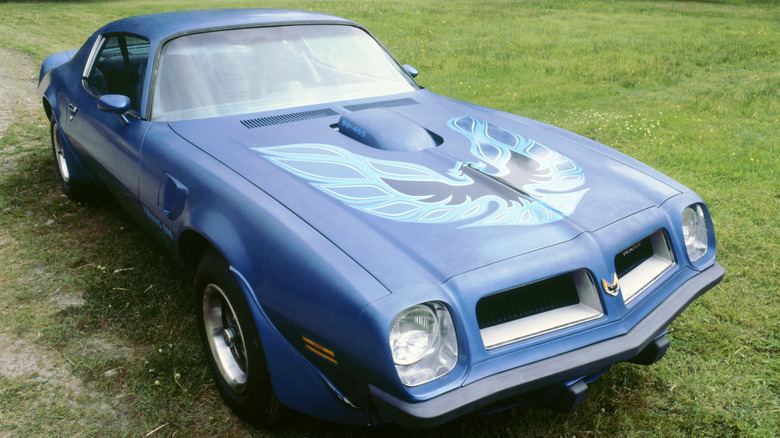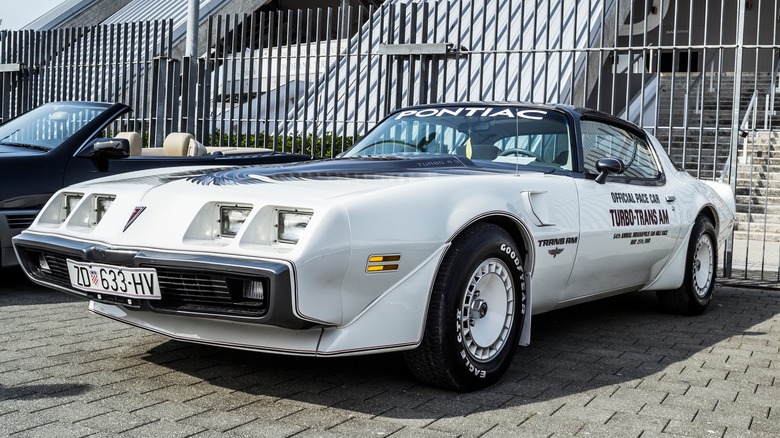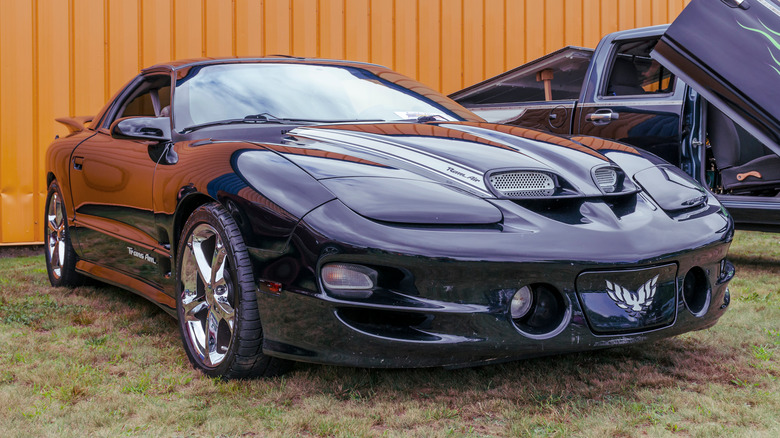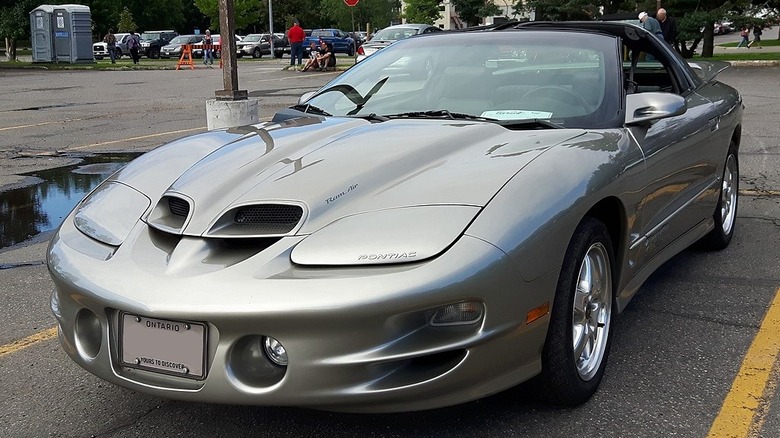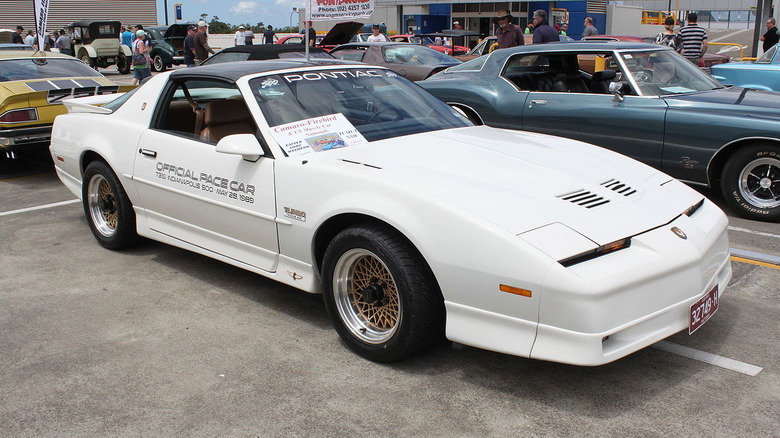How The Pontiac Trans Am Went From Iconic Movie Car To Extinct
For more than three decades, the Pontiac Trans Am was one of the most popular sports cars on North American roads. While it has many detractors, it also retains a large and fervent fan base that keeps these cars on the road and in our memory. The Trans Am is the performance-upgraded model of the Pontiac Firebird, the car originally conceived as a companion to the Chevrolet pony car, the Camaro. While the outward appearance of the cars was nearly identical, the Trans Am offered improved handling and often more power options.
Both Camaros and Firebirds were popular cars from the start and sold well enough to keep them alive through the malaise of the power-starved '70s. The placement of a Trans Am in a hit movie in the late '70s helped boost its image and had the car gracing magazine covers and movie posters for a decade or more. Tran Am may have been among the most popular cars in high school parking lots through the '80s, but the good times would eventually come to an end. With a few explainers of the many facets that made this car unique and desirable, this is how it went from iconic movie car to extinct.
Not the boss' first choice
Famed automotive legend John DeLorean managed Pontiac in the '60s and had been almost wholly responsible for getting the GTO out to dealers and kicking off the muscle car scene. Even as he oversaw the development of the GTO, DeLorean sought to bring another high-performance model to the brand. His initial vision resulted in a concept car called Banshee. It was a two-seat sports car with a curvy fiberglass body powered by the innovative Pontiac 3.8-liter overhead-cam, inline-6 engine.
As stylish and svelte as the Banshee was, it never made it to the factory floor. It never made it out of the design center. When DeLorean showed the concept to executives at GM, the project was killed. Management did not want anything cutting into Corvette sales, and the Banshee was just a little too similar. Therefore, higher-ups told DeLorean they wanted him to take the new platform for the Camaro and create a Pontiac version of it. The Firebird is what resulted (via MotorTrend).
[Featured image by Alden Jewel via Wikimedia Commons | Cropped and scaled | CC BY 2.0]
Trans Am debut
Both the Camaro and Firebird saw immediate success and cars moved off dealer lots at a rapid pace. The original release in 1967 happened during the era of huge power with a degree of brinksmanship among manufacturers producing ever-increasing amounts of power from engines of growing displacement. Jumping on the high-performance bandwagon, Pontiac came up with a high-performance version of the Firebird named for a popular SCCA racing series called Trans Am. According to MotorTrend, the Trans Am series got its start right along with pony cars in 1966. Trans Am racing took place on road racing courses consisting of a variety of curves, turns, and straights that was ideal for lightweight cars with lots of power and good handling.
The first couple of years of Trans Am racing was dominated by the Camaro, but included some Firebirds on the track. John DeLorean wanted to build a performance version of the Firebird to compete with the Z/28 and set his team to upgrade the Firebird. Pontiac had a High Output 400-cubic-inch as an option for the Firebird and GTO already, and this is the engine chosen for the new model. Other upgrades were made to the suspension and braking, and the exterior received new ram-air scoops on the hood along with a spoiler, brake vents, and engine compartment air extractors (via MotorTrend). The name Trans Am was chosen to associate the car with the competitive, powerful, and high-speed nature of the racing series so that consumers would know immediately this car was built to race.
Malaise Era decline
With the passage of the Clean Air Act of 1970, automakers had precious little time to clean up their act, literally. Sections of that bill stipulated that tailpipe emissions of automobiles were to reduce the amount of toxic chemicals progressively and periodically. The science of what needed to be done was clear, but the engineering needed to play catch-up. Therefore, manufacturers instituted many technological changes and additions to cars' engines that helped reduce emissions while simultaneously zapping their power output. The power began to fade in 1973 and would not resume in full force until the '90s, ending what is often called "The Malaise Era."
For the Trans Am, this meant the once-powerful beast of a machine saw its power dwindle to the point that, according to Silodrome, one equipped with a 455-cubic-inch (6.6-liter) V8 was rated at just 220 horsepower, which is only slightly more than a base model Camry. While it still made a fair bit of torque, it was still terribly underpowered considering the size of the engine. Other Trans Am models of the period suffered similar fates with base model V8 engines unable to crack 150 horsepower on a good day. To highlight the long demise of power, Hagerty states that a 1985 Firebird equipped with the LQ9 4-cylinder eked out a paltry 88 horsepower. Fortunately for the Trans Am, better days were still to come.
An automotive movie star
Few things boost fame and notoriety like a good Hollywood blockbuster. Movies have been responsible for blasting not just actors to instant stardom, but also ideas and products in popular culture. The perfect example of this is the two main stars of the smash-hit 1977 movie, "Smokey and the Bandit." This now legendary film is a raucous tale of a trucker bootlegging Coors beer, which was only sold west of the Mississippi at the time, across the South, escorted by a brash, young, and cocky escort with a fast car. It would have been number one at the box office had it not been in the theaters up against the first edition of Star Wars. It starred Burt Reynolds and Sally fields. Reynolds was already an accomplished actor, with this film cementing his place in Hollywood and pop culture — but it also made a star out of the black Pontiac Trans Am he drove.
GM gave the production five cars to use in the film. The movie car was a 1977 Pontiac Firebird Trans Am with a 6.6-liter V8, t-tops, and shaker hood, which had an opening for a protruding air intake, although it was only decorative. It also featured gold honeycomb aluminum wheels with matching pinstriping and the iconic golden hood decal. While it was an underpowered car, it roared on screen and instantly boosted sales at dealers to the point that Pontiac delayed the next year's redesign (via Top Speed). More recently, one of the original movie cars, owned by Burt Reynolds himself, was auctioned for half a million dollars.
The Screaming Chicken
The aforementioned golden graphic on the Bandit's car was first made available as an option on the Trans Am in 1973. It has the appearance of a fiery eagle or phoenix but its official name as a factory option, according to Motor Trend, was the Trans Am Hood Decal. However, at some point along the way, it colloquially became known as the "Screaming Chicken." The genesis of the decal comes from the designers at Pontiac that wanted to add graphics to the Trans Am that would build upon the original Firebird emblem on the debut model.
A similar graphic had been displayed on the Banshee II concept in 1969, and that was the inspiration for a larger one to adorn the Tran Am. Pontiac designers put together preliminary designs for it, but the project was nearly scuttled. GM design chief Bill Mitchell did not like the idea and would not have approved it for production. However, one of the designers created a gold prototype version and applied it to a black Trans Am to be displayed outside of Mitchell's office next to his motorcycle, which the same designer had previously applied a black-and-gold paint scheme to in the style of Lotus race cars of the day (via Hemmings). It was subsequently approved as an option the next year and later became standard on all Trans Ams, becoming the most recognizable element of the car for years.
The last muscle car
The 1974 Trans Am Super Duty 455 is, according to Autoweek, the last muscle car. New for the 1973 model year, Pontiac's Super Duty 455 (7.5-liter) V8 seemed to show up at the wrong time. When presented to the automotive press, journalists raved about it, excited to see anyone still making a car with big power. Despite new Clean Air Act regulations, it was originally rated at 310 horsepower, but Pontiac had a VW-style trick up its sleeve 40 years before Dieselgate.
The EPA mandated a new Exhaust Gas Recirculation (EGR) system on all cars that year. The emissions test ran for 50 seconds to test the output levels, so Pontiac designed a valve that remained open for 53 seconds before closing (via Horsepower Memories). Unfortunately for Pontiac, the EPA got wise to the scheme and forced Pontiac to change it, and the power was reduced to 290 horsepower, which was still a respectable figure along with its generous 390 pound-feet of torque.
Between 1973 and 1974, Pontiac built just over a thousand copies of the Super Duty, making it one of the most collectible of all Trans Ams. Well-preserved and restored examples can fetch bids of nearly $100,000 at auction today.
Special editions
While the Trans Am was originally an upgraded model of the Firebird, it also spawned several special editions itself. Many of these cars were released at a time when horsepower was too low to be a good selling point, so other methods were needed to market them successfully. Appearance packages are often the best way to draw interest to a car when its specifications don't stand out. But that is not to say these were not interesting cars.
The first of these was the 1976 Trans Am Limited Edition, which debuted the black and gold color scheme on a production model. The 1977 Trans Am Special Edition was the appearance package seen on the car driven by the Bandit in the movie. Then, 1980 saw a turbo added to the Pontiac 301 V8, but still only produced 210 horsepower, per Autoevolution. Still, it was 55 horsepower more than the base model, and it was also released as the NASCAR Pace Car model in 1981. The 20th Anniversary model in 1989 used the same excellent 3.8-liter turbocharged V6 from the Buick Grand National, making for a potent '80s muscle car. The year 1999 saw a 30th Anniversary model painted in the style of the original and the final year, 2002, the Collector's Edition Trans Am was released with the potent WS6 package LS1 V8 with 325 horsepower.
Final generation
Pontiac redesigned the Firebird with a completely updated platform for the fourth generation in 1993. All of the sharp angles and creases of the '80s had been smoothed over and rounded out with what would become the final generation of Trans Am. It was with this generation that Firebirds and Trans Ams received many of the modern elements we see as standard equipment in cars today, such as airbags, anti-lock brakes, and rack and pinion steering. Successive years of the cars would also see an increasing degree of digital componentry in the in-car entertainment and comfort areas, as well as engine management and transmission. Furthermore, aggressive horsepower returned in the later years, finally delivering cars with more than 300 horsepower for the first time in decades (via Consumer Guide).
Despite the many improvements and updated styling, the fourth-generation Trans Am got off to a rocky start. The new body curves tended to be a love-it-or-hate-it affair, and sales figures reflected this dichotomy. The debut year for total Firebird production for 1993 was just 14,112 units, according to Automobile Catalog, with a significant jump to 51,523 the next year. The following years declined until it was discontinued after the 2002 model year.
Power returns
While the fourth generation may have hit a sales slump, horsepower finally returned. The first Trans Ams of the final generation ditched the Tuned Port Injection 350 V8 in favor of the new LS1 V8 seen in the Corvette a year earlier, which gave it an extra 30 horsepower over the previous model, per Hagerty. Finally, in 1998, Trans Am received the legendary LS V8 and gave it the ability to bring back the power of its glory days without the noxious emissions.
Fourth-generation cars also received the option of the WS6 package in 1996. This would transform the car from a good-performing car with 285 horsepower back to a real muscle car with 305 horsepower and 335 pound-feet of torque, cracking the 300 mark for the first time since 1973. The WS6 package added the Ram Air intake and hood along with suspension updates and larger wheels with Z-rated tires (via Hagerty). The later WS6 cars are fast in a straight line but also handle curves adeptly and they are the most sought-after of the last Trans Ams. In the final year of production, Pontiac built perhaps the best of all modern Trans Am models with the 2002 Trans Am Firehawk, which tuned the LS1 up to a healthy 345 horsepower backed up by a 6-speed manual transmission. The Pontiac muscle car had finally returned.
[Featured image by Elise240SX via Wikimedia Commons | Cropped and scaled | CC BY-SA 4.0]
A sad demise
While Pontiac's muscle had returned, it would be bittersweet as sales of both the Firebird and Camaro had declined to the point that GM decided to nix both cars. Pontiac was without a fast coupe until it began importing the Australian Holden Monaro as the Pontiac GTO in 2004, but it failed to garner the excitement of the Trans Am. While it is a powerful and capable car with an LS1 and LS2 V8, the styling is a bit understated and bland for those wanting a car from the "We Build Excitement" brand, and it was discontinued after the 2006 model year (via Autoblog).
The Trans Am moniker may have been ripe for a return if not for the events of the 2008 global financial crisis. Faced with bankruptcy and government bailouts, GM had to act decisively to survive and keep the entire company from folding. Ultimately, management decided to axe some of its core brands, and that included Hummer, Saturn, Saab, and Pontiac. According to GM Authority, the decision to end Pontiac came from its troubled profitability in recent years and the fact that Buick was one of the most popular brands in China, which, at the time, was the fastest-growing car market in the world with the potential to become many times larger than even GM's home market. Thus, the revival of the Camaro in 2010 would not be accompanied by the Firebird or Trans Am.
[Featured image by Jeremy via Wikimedia Commons | Cropped and scaled | CC BY 2.0]
